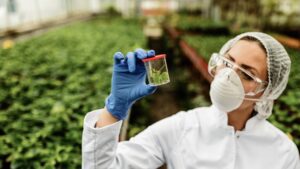Like vitamins and the other supplements that keep you in good health, they also benefit your field’s soil. But you wouldn’t take nutrients you don’t need; you’d have the doctor run soil testing and analysis to determine what was best for you. Because the soils in different fields can vary widely in nutrient composition, broadcasting fertilizers randomly can do more harm than good. If you use too much fertilizer, you can burn your crop. The more nitrogen, the better it is to green up a plot. However, excessive nitrogen can promote a disease called “brown patch,” which causes symptoms as its name describes.

Source: Freepik
Soil testing and analysis:
There are 18 essential nutrients necessary for healthy plant growth. The air supplies three of these — oxygen, hydrogen, and carbon —. But a plant has to receive the other 15 nutrients from the soil. This is one of the primary functions of plant roots — absorbing the essential elements a plant needs. A soil test determines the levels of nutrients in the soil. It lets you know whether there are deficiencies or excesses. A practical soil test also recommends which fertilizer variant you must apply to your plot of land to fix the deficiencies.
What does a soil analysis help to do?
A soil analysis thoroughly examines the soil within and below a root zone. A single shovelful of soil will reveal the soil’s properties: texture, pH, organic matter, density, structure, and biology. There are various soil layers and together, they comprise of the soil profile, and the interrelationship of these layers is also an essential feature. Plant performance will be affected if any of these properties are degraded. And if many degrade, severe plant decline or failure can result. Analysis and in-depth understanding of all the properties throughout the soil profile are also critical.
When is soil testing helpful?
Certain chemical elements occur naturally in the soil layers as components of minerals, yet may be toxic at some concentrations. Other potentially harmful substances may end up in soils through human activities. This could happen if former industrial or agricultural lands are later used for residential properties, and contaminants remain in the soil. Spills, runoff, or aerial deposition of chemicals used for agriculture or industry can also cause soil contamination in residential areas. At times, the amounts of some soil elements and other substances may exceed levels recommended for the health of humans, animals, or plants.
Soil testing and analysis can help answer questions and address concerns about possible contamination. The sampling strategies outlined here can also guide efforts to test soils for other properties, such as pH, nutrient levels, or organic matter content. When deciding how the soil tests can be helpful in a particular situation, consider the cost of analysis and the property’s location, size, history, current use, and overall soil quality.
General procedure for soil sample collection:
- Select the sites. Select the specific locations to collect samples based on the questions to be answered with test results, or by following the recommendations of the specific program you are using.
- Make a map or diagram using a farm management software. Record where and how samples are collected (including the depth of soil collected), and label the samples accordingly. This information will help interpret the test results from the laboratory.
- Collect the samples. At each sampling location, remove all the surface vegetation and for that use a clean soil probe to collect the sample to avoid contamination. For individual samples, it’s recommended to wash the soil probe with soap and water between samples. Using the same sampling instrument to mix the five to ten samples for a composite sample is acceptable.
- Package the samples. For individual (not composite) samples, put each sample into a different lab-approved sample bags. For composite samples, mix the individual samples in a clean container (such as a clean plastic bag placed inside a bucket) and then transfer the mixed sample to the container sent to the laboratory. Follow the instructions provided by the soil laboratory regarding how to package and label the soil samples.
- Send the sample(s) to the laboratory as instructed. Select an appropriate shipping option if samples need to be analyzed within a specified time frame.
Contact your local SoilOptix®expert to learn more about soil testing and nutrient programs.
